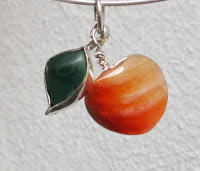
It’s been quite a while since my last blog. I can blame it on acts of nature such as the holiday period, but, to tell the truth, other things kept me busy. As usual I bought tumbled gemstones on the ‘exotic’ foreign markets (if Ukraine can be considered exotic enough). Besides that my friend who lives in the Urals brought me quite a bunch of semiprecious stones for my birthday. The choice was hers not mine, and yes, they were beautiful. But as often with gifts your first emotion is saying ‘thank you’. It is not like the flash of inspiration you feel when you SEE the stone and you know exactly what you are going to make.
Actually I had no idea what I should do with them. Large, chunky and very difficult to set into a standard bezel. Fortunately the groove wire wrapping technique described here helps a lot, provided the stones are strong enough to sustain the cutting. But it’s not the whole story.
The groove wire wrapping technique works best with pendants, because of the logical “ending” of the loop which becomes a bail. It is extremely difficult to apply it to rings, because of the connection to be made between the wired part and the ring shank. I only made one ring using this technique, the cat ring shown at the end of this post. So most of these stones will become pendants.

Another point is the shape of the stone itself – a 3D shape, because a stone without a (more or less) flat surface will never make a perfect contact with the skin. It will behave too restless, move and swing too much. Ideally, in order to save cutting and polishing work (and precious tools) the stone should have ready-to-wear shape, like this citrine.
When I looked at it, the stone “told me” to keep it as it is and to provide it with a sunny sparkling frame. The irregular shape of the stone fits into a frame of a fuzzy design. No perfect straight lines needed. I just loved it. The citrine is a splash of joy and inspiration.

However, not all stones are that easy. The three other stones featured here required a different approach. Their original shape was a bit like something, but what? So I observed them closely, visualized them even when I was doing other things like watching TV (Such distraction is not good in general, but visualizations are a nice way to fill commercial breaks.)


Finally I decided to help the tumbled gemstones to get into shape by slightly cutting their sides. Since my stone cutting tools are far from being perfect, the cutting had to be limited to the minimum. After that the edges were polished using stone polishing discs. That was not easy. While the supplier (no names mentioned here because I am not quite satisfied with the products and the information provided on their site) advised to use water for lubrication, it turned out that the glue which fastens the discs to mandrels is not quite water-resistant, so some of the discs started falling off during polishing. The advertised mirror polish has been never achieved either. But at least the polishing took off some rough edges.
At the end of the day the stones acquired suggestive shapes: a leaf, an apple, a heart. So I could proceed with making pendants.
These three tumbled gemstones looked very fit for a set. What did happen to them finally? Read my future blog.

Leave a Reply